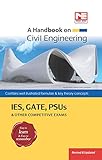Civil Engineering Handbooks eBook

Civil Engineering Handbooks eBook This book contains information obtained from authentic and highly regarded sources. Reprinted material is quoted with permission, and sources are indicated. A wide variety of references are listed. Reasonable efforts have been made to publish reliable data and information, but the authors and the publisher cannot assume responsibility for the validity of all materials or for the consequences of their use.
Civil Engineering Handbooks eBook
Preface
The second edition of the Civil Engineering Handbook has been revised and updated to provide a
comprehensive reference work and resource book covering the broad spectrum of civil engineering. This book has been written with the practicing civil engineer in mind. The ideal reader will be a BS- or MSc-level engineer with a need for a single reference source to use to keep abreast of new techniques and practices as well as to review standard practices.
The Handbook stresses professional applications, placing great emphasis on ready-to-use materials. It contains many formulas and tables that give immediate solutions to common questions and problems arising from practical work.
It also contains a brief description of the essential elements of each subject, thus enabling the reader to understand the fundamental background of these results and to think beyond them. Traditional, as well as new and innovative practices, are covered.
As a result of rapid advances in computer technology and information technology, a revolution has occurred in civil engineering research and practice. A new aspect, information technology and computing has been added to the theoretical and experimental aspects of the field to form the basis of civil engineering.
Thorough coverage of computational and design methods is essential in a knowledge-based economy. Thus, computational aspects of civil engineering from the main focus of several chapters. The Civil Engineering Handbook is a comprehensive handbook, featuring a modern CAD/CAE approach to advancing civil engineers in the 21st century.
The handbook is organized into eight sections, covering the traditional areas of civil engineering: construction engineering, materials engineering, environmental engineering, structural engineering, geotechnical engineering, surveying engineering, hydraulic engineering, and transportation engineering.
The subdivision of each section into several chapters is made by the associate editors and is somewhat arbitrary, as the many subjects of the individual chapters are cross-linked in many ways and cannot be arranged in a definite sequence.
To this end, in addition to the complete table of contents presented at the front of the book, an individual table of contents precedes each of the eight sections and gives a general outline of the scope of the subject area covered.
Finally, each chapter begins with its own table of contents. The reader should look over these tables of contents to become familiar with the structure, organization, and content of the book.
It can be used as an introduction to or a survey of a particular subject in the field, and the references at the end of each chapter can be consulted for more detailed studies.
The chapters of the Handbook have been written by many authors, all experts in their fields and the eight sections have been carefully edited and integrated by the various associate editors in the School of Civil Engineering at Purdue University and the Department of Civil Engineering at the National University of Singapore.
This Handbook is a testimonial to the dedication of the associate editors, the publisher, and the editorial associates. I wish to thank all of the authors for their contributions and the reviewers for their constructive comments.
I also wish to acknowledge CRC Press, Helena Redshaw, Elizabeth Spangenberger, Susan Fox, and Cindy Carelli for their professional support in revising this handbook.
W. F. Chen
J. Y. Richard Liew
Editors-in-Chief

 | |
 |
|
Disclaimer:- Dev Library is not the owner of the books and neither does it create books. We just provide the links to the book for the rural and poor students who can’t afford to buy books. Those E-Books and PDFs are already available on the internet. For any reason, if someone thinks that I’m violating any laws or if anyone has any issues regarding this, please feel free to Contact Us.

Hi, I’m Dev Kirtonia, Founder & CEO of Dev Library. A website that provides all SCERT, NCERT 3 to 12, and BA, B.com, B.Sc, and Computer Science with Post Graduate Notes & Suggestions, Novel, eBooks, Biography, Quotes, Study Materials, and more.








